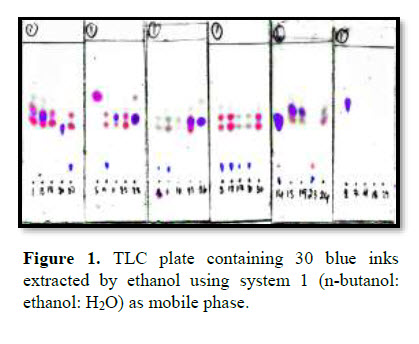Separation of Blue Ballpoint Pen Inks- A Comparison of Solvent Systems on Thin Layer Chromatography Techniques
Keywords:
Forensic, Ballpoint pen inks, Thin-layer chromatography, Ink analysisAbstract
This article is chromatographic analysis of inks for forensic science. Thin layer chromatographic technique (TLC) is often used in separation of writing inks because it is rapid and requires no sophisticated instrumentation. The repeatability and reproducibility of TLC analyses of inks depend on several factors. However, the critical importance is the use of solvent for the extraction process and for mobile phase. The purpose of the present study is to compare the effectiveness of blue ballpoint pen ink separation by TLC
between different solvent extraction and variant mobile phase systems. Thirty blue ballpoint pens commonly used in Thailand were extracted from document then three solvents (ethanol, acetone or dichloromethane) and five solvent systems as mobile phase were used to separate pigment compounds in each sample. The Rf values were calculated for discrimination analysis of all blue pens via two-way ANOVA. The results showed that the most important factor affecting ink classification was solvent extraction. The ethanol was the best solvent for extraction and the optimal mobile phase was n-butanol: ethanol: water (50:15:10 v/v/v) having statistically
significant level of 0.05. This mobile phase system could be used to classify all 30 inks into 12 different groups with the discrimination power (DP) of 89.20%. In the future, the qualitative data from TLC plates will more reliable by multivariate statistical techniques can also be applied on effectively interpretation.
References
Barker, J., Ramotowski, R., & Nwokoye, J. (2016). The effect of solvent grade on thin layer chromatographic analysis of writing inks.Forensic Science International, 266, 139-147.
Djozan, D., Baheri, T., Karimian, G., & Shahidi, M. (2008). Forensic discrimination of blue ballpoint pen inks based on thin layer chromatography and image analysis. Forensic Science International, 179(2-3), 199-205.
Feraru, D.-L., & Meghea, A. (2014). Possibilities to differentiate ballpoint pen inks by spectroscopic and chromatographic techniques.UPB Scientific Bulletin, Series B: Chemistry and Materials Science, 76(1), 113-126.
Ismail, D., Austad, Z., & Mat Desa, W. N. S. (2014). Ultra-violet and visible (UV-Vis) spectroscopy and chemometrics techniques for forensic analysis of ballpoint pen inks: A preliminary study. Malaysian Journal of Forensic Sciences, 5(1), 47-52.
Lee, L. C., Shandu, K. T. S., Razi, N. S. M., Ishak, A. A., & Osman, K. (2015). Forensic analysis of blue ballpoint pen inks using ultravioletvisible spectrometer and ultra-performance liquid chromatograph. Malaysian Journal of Analytical Sciences, 19(2), 397-401.
Lewis, J. A. (1996). Thin-layer chromatography of writing inks- Quality control considerations. Journal of Forensic Sciences, 41(5), 874-877.
Roux, C., Novotny, M., Evans, I., & Lennard, C. (1999). A study to investigate the evidential value of blue and black ballpoint pen inks in Austratia. Forensic Science International, 101(3), 167-176.
Samanidou, V. F., Nikolaidou, K. I., & Papadoyannis, I. N. (2004). Development and validation of a gradient-HPLC-PDAD method for the identification of ballpoint pen ink components: Study of their decomposition on aging for forensic applications. Journal of Liquid Chromatography and Related Technologies, 27(2), 215-235.
Senior, S., Hamed, E., Masoud, M., & Shehata, E. (2012). Characterization and dating of blue ballpoint pen inks using principal component analysis of UV-Vis absorption spectra, IR spectroscopy, and HPTLC. Journal of Forensic Sciences, 57(4), 1087-1093.
Smalldon, K. W., & Moffat, A. C. (1973). The calculation of discriminating power for a series of correlated attributes. Journal of the Forensic Science Society, 13(4), 291-295.
Thanasoulias, N. C., Parisis, N. A., & Evmiridis, N. P. (2003). Multivariate chemometrics for the forensic discrimination of blue ball-point pen inks based on their Vis spectra. Forensic Science International, 138(1-3), 75-84.
Vila, A., Ferrer, N., & Garcia, J. F. (2007). Chemical composition of contemporary black printing inks based on infrared spectroscopy: Basic information for the characterization and discrimination of artistic prints. Analytica Chimica Acta, 591(1), 97-105.
Vogt, C., Vogt, J., Becker, A., & Rohde, E. (1997). Separation, comparison and identification of fountain pen inks by capillary electrophoresis with UV-visible and fluorescence detection and by proton-induced X-ray emission. Journal of Chromatography A, 781, 391-405.
Zlotnick, J. A., & Smith, F. P. (1999). Chromatographic and electrophoretic approaches in ink analysis. Journal of Chromatography B: Biomedical Sciences and Applications, 733(1-2), 265-272.













